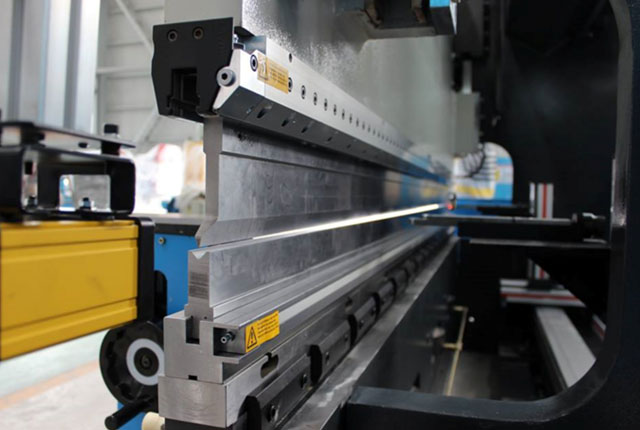WMT CNC Industrial Co., Ltd | All Rights Reserved.Design & Developed by VW Themes

There are many materials that can be used to produce press brake tools, such as steel, alloy materials, polymer materials and so on. However, at present, most of the materials for the production of press braketools are steel, including T8 steel, T10 steel,42CrMo, and Cr12MoV.
42CrMo is a high-strength alloy quenched and tempered steel with high strength and strong toughness.Itcan work under a temperature of -500°℃. lt mainly requires high strength high toughness, and good wear resistance.
The common types of press brake die materials can be divided into the following eight categories:
T8A and T10A carbon tool steels are common in the production of press brake dies, with good processability and low price. However, the hardenability and red hardness are poor, the heat treatmentdeformation is large, and the bearing capacity is low.
Adding an appropriate amount of alloy elements on the basis of carbon tool steel is a low alloy tool steel,which reduces quenching deformation and cracking tendency, improves the hardenability and wear resistance of the steel.Low alloy steels commonly used in the production of press brake dies includeCrWMn,9Mn2V,7CrSiMnMoV,6CrNiSiMnMoV.
High carbon and high chromium tool steel has good hardenability, hardenability and wear resistance, andthe heat treatment deformation is very smal It is a high wear-resistant micro deformation press brake diesteel, and its bearing capacity is second only to high-speed steel.However, due to severe carbide segregation, repeated upsetting and drawing (axial upsetting and radial drawing) must be carried out toreduce the heterogeneity of carbide and improve the service performance.
Common high carbon and high chromium tool steels include Cr12,Cr12MoV and Cr12MoV1.
High carbon medium chromium tool steels used for press brake dies include Cr4W2MoV, Cr6W, Cr5MoV,etc.They have low chromium content, less eutectic carbides, uniform carbide distribution, small heattreatment deformation, good hardenability and dimensional stability. Compared with high carbon and highchromium steel with relatively serious carbide segregation, the properties are improved.
High-speed steel has the highest hardness, wear-resistance and compressive strength of press brake diesteel, and has high bearing capacity. W18Cr4V, W6Mo5 and Cr4V2 with less tungsten and 6W6Mo5 andCr4v high-speed steels developed to improve toughness are commonly used.High-speed steel also needsto be forged to improve its carbide distribution.
Basic steel is to add a small amount of other elements on the basis of high-speed steel and increase ordecrease the carbon content to improve the properties of steel. It has certain wear resistance and hardness, and its fatigue strength and toughness are better than high-speed steel.It is a press brake diesteel with high strength and toughness, and the material cost is much lower than that of high-speed steel.The basic dry materials commonly used in press brake dies include 6Cr4W3Mo2VNb,7Cr7Mo2V2Si,5Cr4Mo3SiMnVAL, etc.
The hardness and wear resistance of cemented carbide are the highest in press brake die steel, but thebending strength and toughness are poor.The cemented carbide used as the press brake die is tungstencobalt. For the press brake die with low impact and high wear resistance, the cemented carbide with low cobalt content can be selected.For press brake dies with high impact, cemented carbide with high cobaltcontent can be selected.
Steel bonded cemented carbide is sintered by powder metallurgy with iron powder added with a smallamount of alloy element powder(such as chromium, molybdenum, tungsten, vanadium, etc.) as binder andtitanium carbide or tungsten carbide as hard phase.The matrix of steel bonded cemented carbide is steel,which overcomes the shortcomings of poor toughness and difficult processing of cemented carbide. It canbe cut, welded, forged and heat treated.Steel bonded cemented carbide contains a lot of carbides.
Although its hardness and wear resistance are lower than that of cemented carbide, it is still higher thanother steel grades.After quenching and tempering, the hardness can reach 68-73 HRC.
The material used for the press brake tool belongs to cold working die steel, and the main performancerequirements include strength, toughness and wear resistance. At present, the development trend of pressbrake die steel mainly includes two directions, but both are based on high alloy steel D2(Cr12MoV);
(1) lmprove the toughness of press brake die: reduce the carbon content and alloy element content, andimprove the uniformity of carbide distribution in steel, such as 8CrMo2V2Si,Cr8Mo2SiV;
(2) lmprove the wear resistance of press brake die to adapt to powder high-speed steel developed for high-speed, automatic and mass production, such as 320CrVMo13.